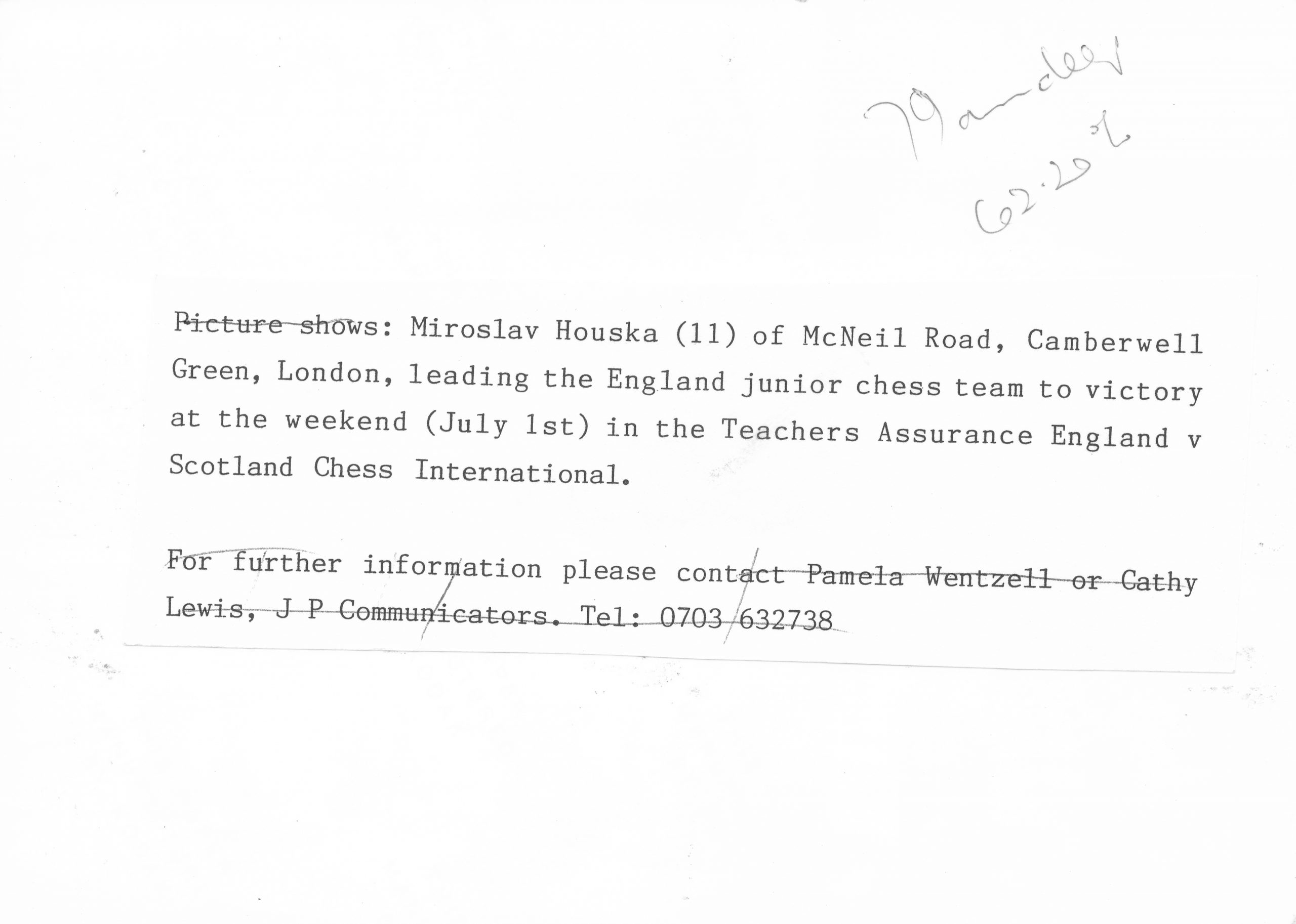
Birthday of IM Miroslav Houska (02-iv-1978)
Miroslav gained his International Master title in 1998 and his peak rating according to Felice was 2385 in January of 1998, aged 20.
Here are his games on chessgames.com



Birthday of IM Miroslav Houska (02-iv-1978)
Miroslav gained his International Master title in 1998 and his peak rating according to Felice was 2385 in January of 1998, aged 20.
Here are his games on chessgames.com



Cyrus Lakdawala is an IM and former US Open Champion who teaches chess and has written over 25 books on chess openings.

The Petroff (or Petrov or Russian) Defence has long been regarded as one of the most solid replies to 1.e4. The most prolific player of the Petroff is Artur Yusupov, a Russian Grandmaster who had played it in around 200 games according to MegaBase 2019.
Vladimir Kramnik , Anatoly Karpov and Boris Gelfand have also used the Petroff many times whilst recently Fabiano Caruana has made it one of his most important and reliable defences.

This is a repertoire book from the Black perspective and therefore does not include all possible black variations but it does provide clear recommendations for dealing with the White variations.
Following the Introduction we have six in-depth chapters as follows :
Each and every chapter starts with a summary of the variation to put the reader into the right frame of mind.
The author kicks-off in detail by examining the somewhat swashbuckling Cochrane Gambit where, after the moves 1.e4 e5 2.Nf3 Nf6 3.Nxe5 d6 White boldly sacrifices a knight with 4 Nxf7?!. The author concludes that the Cochrane Gambit is dubious and Black has excellent winning chances (which you would expect no doubt).
He backs this up by showing how Black should play after 4…Kxf7 when White has three sensible moves 5.d4 5.Bc4+ and latterly 5.Nc3 (which was played in a rapid game by Vasily Ivanchuk) : all 3 games were won by Black who wins a piece for 2 pawns. According to MegaBase 2019, the gambit scores an amazing 58.8% for white over 910 games so in practise (as opposed to theory) it does pretty well !
Next, we turn to the Scotch Petroff in which White plays 3.d4 when 3…Nxe4 is recommended.
Two main lines are given, the first being 4.d4xe5 d5 5.Nbd2 where, in the game Vitiugov v Caruana 2018, Black played 5…Qd7 and excellent annotations are given as to why this move equalises fully.
The more popular 5 Nc5 is also examined in detail and,
more often than not, more than one playable line is given for the reader to choose from.
Following the examination of 3.d4 Nxe4 4.Bd3 d5 5.Nxe5 Nd7 Laznicka v Shirov 2006 is discussed in detail and this is an interesting game in which Black was able to win from a lost position.
The opening however was again fine for black.
In Chapter three the author pitches into, what most would consider as THE main line i.e. 3. Nxe5 which is played in 53% of games in MegaBase 2019.
Cyrus recommends 3…d6 4.Nf3 Nxe4 5 d4 d5 6 Bd3 Be7 7 00 Nc6 as most promising for Black.
The main line here is 8.c4 and ten games are annotated in detail. The most prominent players of the black pieces include Vishy Anand and Anatoly Karpov. The following game is annotated in detail :
Other popular moves (8. Re1 and 8.Nc3) are also considered in the same lengthy main chapter.
So called off-beat or side lines are covered in Chapter Four the most important of which is 3.Nxe5 d6 4.Nf3 Nxe4 5.Qe2 which the author labels “The Dull Variation” but, as Cyrus points out, it is a likely choice for the White player if he or she is greatly outgraded and happy to halve the point. However, as in the game Luke McShane v Ba Jobava, Black managed to out dull the dullness by winning!
The so-called “New Main Line” is considered in Chapter Five and this is 3.Nxe5 d6 4.Nf3 Nxe4 5.Nc3 which, somewhat famously, is the usual choice of Magnus Carlsen (and Alexei Shirov) when battling the Petroff. The usual consequence of adoption of a line by the World Champion is that the variation becomes popular at “club level”. (Editor : This also happened to the currently trendy new main line of the London System : 1.d4 d5 2.Bf4 Nf6 3.e3 c5 4.c3 Nc6 5.Nd2).
The chapter launches by detailing a recent (2018) Carlsen v Caruana game where again, black equalises and draws the game.
The final chapter covers the Three Knights Variation in which White essays 3.Nc3 and Black usually replies 3…Bb4 : of course, he or she could also try 3…Nc6 transposing to a Four Knights Game.
From the BCN Editor :
As with every recent Everyman Chess publication high quality paper is used and the printing is clear. Each diagram is clear as is the instructional text. Figurine algebraic notation is used throughout and the diagrams are placed adjacent to the relevant text.
A couple of small gripes with the production are : the diagrams do not have a “to move” indicator. secondly, some Everyman books (but not this one) have an extra folding part to the front and rear covers. These we find protect the book from damage and also can be used as an emergency book mark !
So, what do we think ?
This is an excellent book with 58 games often by world class players given lots of analysis and discussion of ideas.The author sets many exercises (tactical and strategic) for the reader to work through making the book more interactive than many.
Of course, it is mainly written from the Black perspective as most presented games are won by Black perhaps making the reader wonder why 2…Nf6 is not as popular as 2…Nc6 : maybe it soon will be !
Colin Lyne, Farnborough, Hampshire, October 22nd, 2019
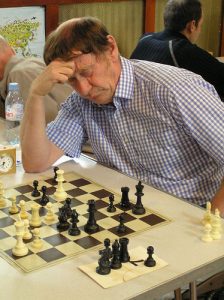
Book Details :
Official web site of Everyman Chess

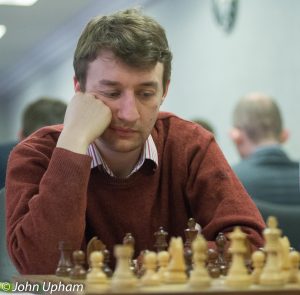
Luke McShane has made a welcome return to chess journalism as the columnist for The Spectator. At fifteen Luke provided a regular column for The Express on Sunday and, until recently, was a busy full-time trader at Goldman Sachs.
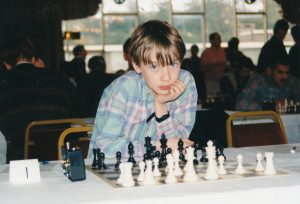
The first chess columnist for The Spectator was Conel Hugh O’Donnell Alexander who was followed by Raymond Keene who “retired” in 2019.
Luke’s most recent article may be found here.

We look forward to original and interesting articles from Luke !

We send best wishes to Richard Kenneth Guy on his 102nd birthday, this day (September 30th) in 1916
From Wikipedia :
Richard Kenneth Guy (born 30 September 1916) is a British mathematician and professor emeritus in the Department of Mathematics at the University of Calgary.[1] He is known for his work in number theory, geometry, recreational mathematics, combinatorics, and graph theory.[2][3] He is best known for co-authorship (with John Conway and Elwyn Berlekamp) of Winning Ways for your Mathematical Plays and authorship of Unsolved Problems in Number Theory.[4] He has also published over 300 papers.[5] Guy proposed the partially tongue-in-cheek “Strong Law of Small Numbers,” which says there are not enough small integers available for the many tasks assigned to them – thus explaining many coincidences and patterns found among numerous cultures.[6] For this paper he received the MAA Lester R. Ford Award.[7]
From 1947 to 1951 Guy was the endings editor for the British Chess Magazine.[40] He is known for almost 200 endgame studies. Along with Hugh Blandford and John Roycroft, he is one of the inventors of the GBR code (Guy–Blandford–Roycroft code), a system of representing the position of chess pieces on a chessboard. Publications such as EG magazine use it to classify endgame types and to index endgame studies.[41]


A glorious Saturday (the 14th) in September was the date and Camberley Baptist Church was the location of the third tournament in memory of correspondence Grandmaster Keith Bevan Richardson.

A field of thirty-two gathered at the home (since 1982) of Camberley Chess Club for a six round rapid-play event (R20′ + 10″) that was free to enter raising money by donations to The Cure Parkinson’s Trust. Players were invited to choose books from Keith’s library

and donate to charity in return.

Top seed was recently qualified IM Adam C Taylor (ECF230)

whose chances were dented by losing in round 4 to Clive Frostick (Farnham) who, like Keith, was a highly successful correspondence player (a SIM : Senior International Master)

Other pre-tournament favourites were FM Andrew P Smith (IRE and Bourne End)

and FM Richard M Webb (Crowthorne)

along with WFM Louise Head (Crowthorne)

Following three rounds we stopped for lunch (in some cases liquid only) and on 100% were Adam, Clive and Andrew so round four could well be a key decider. Clive beat Adam with the white pieces whereas Andrew and Richard drew a hard fought Sicilian Dragon. In round five Clive breathed a sigh of relief to survive a “dodgy” position against Colin Purdon in one of the candidate games for the “Best Swindle” Prize.

The drama continued into the final round as Adam beat strong junior Ranesh Ratnesan
and everything hinged on Clive’s game with Richard Webb. After a long and interesting struggle the game was drawn and the tournament was decided.
The award for Best U-150 player went to rapidly improving Jessica Mellor (Guildford)

the award for Best Junior went to Radesh Ratnesan (Surbiton)
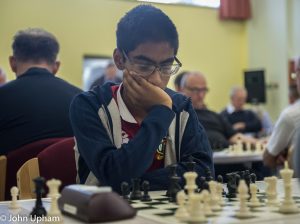
and the title of Camberley Chess Club Champion (highest placed local player) went to Colin Purdon

In overall first place with 5.5/6 was Clive Frostick :
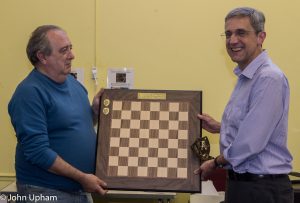
The event collected more than £300 for the Cure Parkinson’s Trust and we are sure Keith was looking down from above and was pleased with what he observed.

Past Winners of Keith Richardson Memorial :
2017 : Julien Shepley
2018 : Ken Norman
2019 : Clive Frostick
Full results may be found from UTU Swiss
Camberley Chess Club would like to thank :
Camberley Baptist Church, Berkshire Junior Chess Association, Ken Coates and Christine Coates.
The organiser was John Upham.

Sixty-four (!) players entered the South-West qualifier for the British Blitz Championship 2019 held at Bristol Grammar School for a fifteen round tournament employing a 3′ + 2″ FIDE approved time control.

The entry was headed by GM Matthew Turner (SCO) scoring 13.5/15 and gaining a mere 8.8 FIDE Blitz rating points drawing quickly with Keith Arkell and losing to FM Lewis Martin (ENG).
Paignton based “local” GM Keith Arkell (ENG) took runner-up spot with 12/15 losing 15 rating points having drawn with Lewis Martin but losing to in-form IM James Cobb (WLS) and IM Malcolm Pein (ENG). Malcolm’s son Jonathan elected to play in the much weaker Belfast qualifier which was probably a good move.

Highest placed lady player (and therefore qualifier) on 8.5/15 was University of Warwick student and reigning English Ladies Champion, WFM Louise Head (ENG) who was supported by her Crowthorne team mates FM Richard Webb, Colin Purdon and Mark Taylor.

Surprise performance (perhaps?) was from FM Lewis Martin (title awarded in 2018) who beat Matthew Turner, Malcolm Pein, Richard Webb and Louise Head of the titled players to earn a 64.8 rating increase.

Full results may be found at Chess Results . com
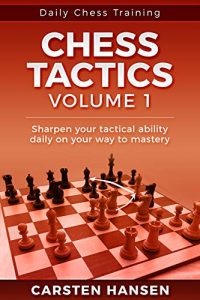
Cartsen Hansen is a Danish FIDE Master, FIDE Trainer and author of twenty-eight chess books on all phases of the game. He is a columnist for American Chess Magazine and Shakbladet.

Chess Tactics is a volume in the series Daily Chess Training the content for which is largely drawn from the authors spaces on various social media platforms such as Facebook, Twitter and Instagram.
The book is self-published and our copy was printed by Amazon Fulfillment which we believe is a low cost method to get books printed with lower volume print runs than you might associate with a so-called main stream publisher. Being a paperback that is fairly thick compared with its other dimensions, it means weights are required to keep the book open hands-free style, unless you want to break the spine. Maybe no other review will mention this but the convenience of reading the book makes a difference for us. It should be noted that a Kindle version is also marketed for those who prefer an eBook format. The printing is fairly clear on off-white paper. What stood out to us immediately was the murkiness / clarity of the diagrams. To be fair to the author we did report this and he has taken this up with his printers.
The main content is divided into seven chapters which have the same rough format of sixteen sets of exercises with four exercises (on average) per set.
For each individual exercise there is a diagram of the starting position, a rating in the forms of asterisk symbols from 1 – 5 where * is straightforward (but not trivial) and ***** means “industrial strength” difficulty. Under the rating is an indicator of who is to move and finally a hint such as
hint : Surprising Consequences to a simple plan.
It is possible to cover up the hint with something handy such as a beer mat (!) should you chose to avoid it.
Following each group of say four exercises there is a solution which usually includes in-depth analysis plus details of the provenance of the game itself.
We could be wrong but every one of the 404 exercises appears to be from 2018 tournament, league or match practice. The author deserves to be congratulated for this aspect alone and this means is it not likely you will have remembered any of the exercises from elsewhere : respect ! Of course, 2018 was an olympiad year which must have helped enormously especially in terms of large disparity in playing strength of the two players.
The overall ethos of the chosen exercises appears to be tactics / combinations that occur in typical games played by mortals leading to winning or large edge positions. In other words they are very pragmatic choices of “meat & potatoes” strong moves rather than jaw-dropping moves that feature in tactics books time and time again.
The author makes it clear that he values feedback and he provides various ways to make contact via his email address and various social media locations. We received an answer to a query within the same day.
Let us examine some examples :
Set 49
Exercises to Set 49
49.1)
**
White to move
Hint : Making room for the right strike
and the solution is :
13.d5!
This clever move takes aim at a surprising piece.
13…Bxd5 14.Nxd6+!
Of course, not 14.Qxd5?? Bb4+.
14…Qxd6 15. Qe3+!
Yes, It is the rook on a7 that’s the target !
15…Kd7 16.Qxa7
Black could have resigned here but dragged the game on to move 20 against her much lower rated opponent.
16…Nc6 17.Qe3 Re8 18.Qd2 Bxf3 19.gxf3 Nd4 20.Qxd4 1-0
A.Avramidhou (2260) – V. Gunina (2528)
Chess Olympiad (women) (Batumi) 2018
and here is a one star problem :
10.3)
and he solution is
16.Bxe6! Nd5
Or 16…fx6 17.Qxe6+ Qe7 18. Qxc6+ Kf7 19.Ne5+
17.Be5 Also 17.Ne5 wins. After 17.Be5 fxe6 18.Bxg7 Rh7 19.Qxe6+ Ne7 20.Qf6, Black is toast.
1-0
C. Bauer(2644) – M. Apicella (2501) Cannes (rapid) 2018.
and, finally an “industrial strength” exercise :
76.2)
and the solution is :
28.d5!
This threatens Bxg7 followed by Qe7+ and game over for Black.
28…Nc3 29.Ba2!!
Without this move White has nothing – did you see it?
29…Qxa2 30.Bxc3 e5
Or 30…Bxc3 31.Qh7+ Kf8 32. Qxb7 and White is winning.
31.Bxe5 Bxe5 32.Qh7+ Kf8 33.Nxe5 White is, of course, completely winning. 33…Bxd5+ 34.Kg1 Bf7 35.Qh8+ Ke7 36.Nc6+ 1-0
M. Parligras(2645) – S.Grigoriants (2543) Hungarian Team Ch. 2018.
There follows an Index of Players and two of these players (Stamy and Sindarov) have five games referenced each. The bulk of the players are not therefore super elite players but mortals.
In summary, this selection of 404 graded exercises covers all of the most common tactical themes plus some rarely encountered ones from modern practice. The commentary for each exercise is detailed enough. The exercises are not grouped according to any particular theme so you are not “expecting something” : you actually have to work it out from scratch in keeping with a real game.
We’d like to see clear diagrams but maybe our reviewer needs to visit Specsavers ! Overall this is good book, packed with original material delivered with a unique style. It will improve your chess ! We look forward to Volume 2….
John Upham, Cove, Hampshire, 29th August, 2019

Book Details :
Official web site of Carsten Chess


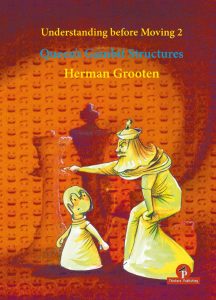
Herman Grooten is an International master, a professional coach for over thirty-five years and has taught players such as Loek van Wely, Jan Werle and Benjamin Bok.

The is the author’s second volume in the Understanding Before Moving series previously having written Understanding before Moving 1 : Ruy Lopez – Italian Structures
As with every recent Thinkers Publishing publication high quality paper is used and the printing is clear. The book can easily be laid flat next to the board and does not require weights to prevent it from “self-closing” (a particular bugbear of ours !). Each diagram is clear and the instructional text is typeset in two column format, which, we find, enables the reader to maintain their place easily. Figurine algebraic notation is used throughout and the diagrams are placed adjacent to the relevant text and each diagram has a “to move” indicator.
The main content is divided into eight chapters :
followed by a collection of 44 unannotated instructive games. There is no index but there is a liberal sprinkling of black & white photographs throughout the instructional text.
The books kicks off by providing the motivation to the reader of the purpose of taking on-board the approach that Grooten adopts. It is clear that he strongly believes studying the typical pawn structures that result from the variations of the Queen’s Gambit the student will gain greater understanding of the correct plans based on those structures. He goes to some trouble to warn students of the modern lazy tendency (younger players take careful note!) to read too much into assessments from modern engines (especially in the opening and transition to the middle game). He, quite correctly, wants the students to use their own eyes and brain to discover ideas and typical themes rather attempting to memorize so-called best moves which change anyway when the engine version is updated.
The advice continues with tips on preparation before and during a tournament which are entirely pragmatic and help the students confidence going into games against both weaker, similar and stronger opponents.
Chapter 3 is where the heavy action starts. We focus on the Carlsbad pawn structure, arising from many variations of the Queen’s Gambit :
and the author details three main plans implied by the above structure followed by twelve high quality instructive examples of these plans from the world’s best players.
For example :
Plan C : Opposite-side castling, 3.10 Pawn Storms on both sides
Position after 12…Rc8In a position with opposite castling it’s of great importance to get one’s attack off the ground as soon as possible. It helps greatly if there is already some weakness in the enemy’s king position , and if it isn’t there – well, the first priority is to force its creation.
13.Ng5
For 13.g4 see the game Petrosian – Ilivitky, Moscow 1965.
13…b5?
In this case it was best to retreat to d7.
14.Be5!
Thus Timman forces Black to weaken himself.
The Pawn Structures chapter essentially provide the ethos of the book putting the student in the right frame of mind for the specific discussion of the variations of interest. As far as I can tell these variations are :
and all of these are treated via a 1.d4 d5 2.c4 e6 3.Nc3 move order.
Some of the above could (arguably if you enjoy this sort of thing!) be said to arise from a Semi-Slav Defence or even Triangle Variation move order (for example the Noteboom / Abrahams and Cambridge Springs variations) so there is more to this book than first meets the eye. The Vienna section is most welcome since it has not hitherto received much attention in the literature and can, of course, become sharp early on.
There is no coverage of the Queen’s Gambit Accepted (the Vienna Variation comes close of course) or of the lines (typically 5. Bf4) where White puts the c1 bishop on f4 rather than g5 : some (including myself) might dub this the Blackburne Variation. There is a brief treatment of the Alartortsev or Cahrousek Variation (3…Be7) included in the Carlsbad section.
For each of the above variations the author highlights the main ideas for white, and to give you some idea here is an example from the Ragozin section :
Position after 10…Kf8in the Interpolistoernooi in Tilburg in 1981 :
11.dxc5!!
Behind this lies a brilliant concept,
11…Nxc3 12.bxc3 Bxc3+ 13.Ke2 Bxa1 14.Qxa1 f6
It’s time to take stock of the position. White has sacrificed the exchange, but has obtained an abundance of compensation in various forms :
- Development and activity
- Bishop pair in an open position
- Unsafe Black king
- Better pawn structure
- Control over d6, which can be used as an outpost by several of White’s pieces
- A position in which “diagonals are more important than files”
All of this then prepares the reader for Chapter 5 : Model Games. There are 15 model games of which 7 cover the Carlsbad, 4 the Tartakower and then one each for the rest except for the Lasker and Vienna Variations.
The reader is then encouraged to test their understanding with 16 exercises of the “White to play and find the best continuation” type. Each of these exercises is analysed in detail in the Solutions chapter.
In summary, this book will be invaluable to any serious student of the Queen’s Gambit, particularly the Exchange Variation and Carlsbad structures. Any player who plays d4 but does not play a quick c4 follow-up (for example, the currently trendy London System followers) may well be sufficiently enthused to “upgrade” their Queen’s Pawn opening to a Queen’s Gambit. The emphasis on understanding via pawn structure analysis will help any student of chess even if do not play 1.d4. Highly recommended !
John Upham, Cove, Hampshire, 22nd August, 2019

Book Details :
Official web site of Thinkers Publishing

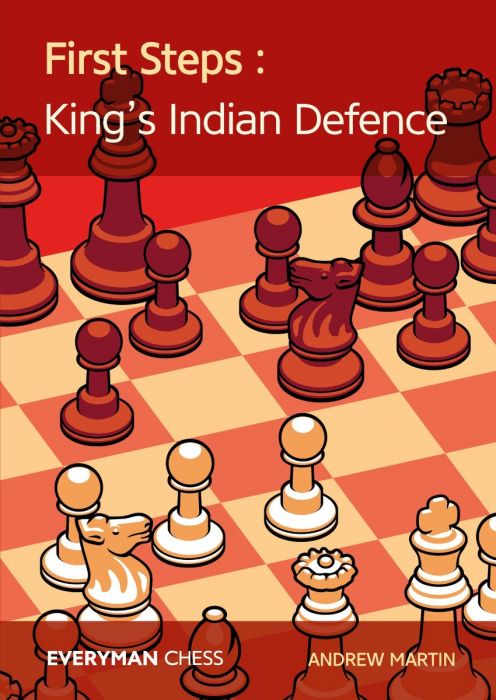
Andrew Martin is an English IM, a Senior FIDE Trainer, the Head of the ECF Chess Academy, a teacher in numerous schools and a coach to many promising and upcoming players. Andrew has authored in excess of thirty books and DVDs and produced huge numbers of engaging videos on his sadly defunct YouTube Channel.

The author first wrote about the King’s Indian Defence (an opening for Black he himself plays) in 1989 (Winning with the King’s Indian) and followed this up with the widely acknowledged King’s Indian Battle Plans in 2004.
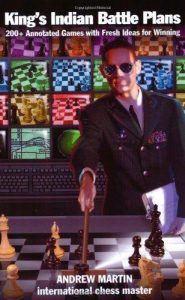
The “First Steps” series from Everyman Chess is (according to Everyman Chess)
an opening series that is ideal for improving players who want simple and straightforward explanations. First Steps emphasizes
- the basic principles
- the basic strategies
- the key tricks and traps
So, bearing the above in mind, does, in true “Ronseal Fashion”, this book do what it says on the tin ?
We have nine chapters :
followed by an Index of Variations and Index of Complete Games (featuring a good number of the author’s own games with both colours).
Interestingly the “Byways” chapter introduces readers to the somewhat rare Dizdar-Indian, which may be new to many :
with around 1200 games in Megabase 2019, being played by Caruana, Mamedov and Fressinet to name drop but a few, this is perhaps a developing sideline should White play Nf3 before Nc3.
Anyway, before I digress too far…
The meat and potatoes of this books kicks off with six decisive (dubbed Inspirational) games which leave one with optimism about a decisive result one way or the other, when employing the King’s Indian Defence. In order to avoid accusations of bias, in game six, Black (Richard Britton), is crushed in 19 moves by Andrew himself :
White to play (and we leave the reader to enjoy finding White’s idea.
Moving on to Chapter Two, Pawn Structures, we find an in-depth discussion of typical themes and idea that arise from the variations to be discussed in subsequent chapters. If only all opening books included such an insightful chapter, players new to the opening would pick up the Good, the bad and the Ugly so much quicker !
The author is also to be thanked for including games where Black gets it very wrong and goes down in flames. Gone are the days of biased books such as “Winning with the Damiano” (OK, I picked an extreme example !) in which Black has somehow refuted 1.e4. This book therefore is much more politically chess correct and credible in what it recommends.
Having studied in detail the Pawn Structures chapter the reader should be in good shape to roll-up their sleeves, pour a glass of wine and get stuck in. For each of the remaining chapters we are introduced to the theory of the set-up selected by our opponent. The Classical System chapter (understandably the largest) features 30 games analysed in detail including emphasis on the ideas, criticism of flawed thinking by either player, top tips that milestone themes the student must understand with plenty of diagrams.
The authors style is friendly, engaging and informal, leaving the student with the feeling that they are having a lesson with the author rather than simply reading a book. This I find helps to make learning the KID a pleasure rather than a chore. You get the feeling you are learning about chess and not just another opening for Black.
To give you a feel here is an excerpt from Chapter Three :
I’m very doubtful whether action in the centre or on the kingside is going to get White anywhere, as he is playing right into Black’s hands. Smirin is now able to whip up an attack.TIP : It is rarely a good idea to play on the side of the board where your opponent is stronger.
17…exf4! 18 Bxf4 Qh4 19 Rael Ng5 20 Kh2 Rae8 21 Qc1
You would think that 21 b64 would be high on the list of White’s priorities, but in this case 21…axb4 Na6 makes it awkward for him to defend his b4-pawn, as the natural 23 Qb3? is met by 23…Be5!
Are there any notable omissions ? A First Steps book is not intended to provide everything but I would have liked to see more detailed coverage of the increasingly popular Bagirov / Krasenkow Variation :
Games 53 & 54 in the section on the Classical Variation do provide coverage to some extent.
And, maybe also a small mention perhaps of the dangerous Barry Attack :
and the KID player (who may not play the Pirc) has to decide if he wishes to allow e4 or play a Grünfeld Defence.
As with every recent Everyman Chess publication high quality paper is used and the printing is clear. Each diagram is clear as is the instructional text. Figurine algebraic notation is used throughout and the diagrams are placed adjacent to the relevant text.
A couple of small gripes with the production are : the diagrams do not have a “to move” indicator. secondly, some Everyman books (but curiously not this one) have an extra folding part to the front and rear covers. These I find protect the book from damage and also can be used as an emergency book mark !
Although I do not play the King’s Indian Defence myself I would certainly be keen to use this book to introduce myself to its rich possibilities. I’m not keen on books written by an author who does not play the recommended system his or herself. In this case there can be no doubt that the advice comes from much experience, enthusiasm and passion for the KID. Please give it a go !
John Upham, Cove, Hampshire, 17th August, 2019

Book Details :
Official web site of Everyman Chess
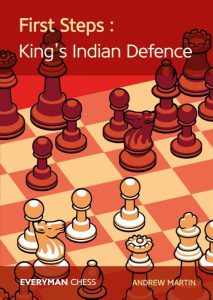
An Attacking Repertoire for White with 1.d4 : Viktor Moskalenko
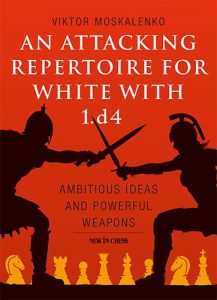
“Half the variations which are calculated in a tournament game turn out to be completely superfluous. Unfortunately, no one knows in advance which half..” – Jan Timman
The value for any practising chess player of a coherent opening repertoire when playing with the white pieces is key to success, enjoyment and efficient use of study time. Books with “Opening Repertoire” in the title are many and varied and we were intrigued to what the emphasis in this latest book from New in Chess would be.
From the books rear cover :
Viktor Moskalenko (1960) is an International Grandmaster and a FIDE Senior Trainer. The former Ukrainian champion’s recent books include The Even More Flexible French, The Wonderful Winawer, Training with Moska and The Fabulous Budapest Gambit.

So, what is An Attacking Repertoire for White with 1.d4 about ?
Up front one factor worth noting is that Moskalenko is advocating a repertoire based around the classical move order approach to playing the “Queen’s Gambit”, viz, 1 . d4, 2.c4 and 3. Nc3 rather than say 1. d4, 2.Nf3, 3.c4 which is, nonetheless, increasing in popularity. Some lines simply do not transpose of course so please bear that in mind !
The author has identified 14 defences employed by Black and offers lines for White against all of these. The variations given attention (and the order in which they are presented ) are :
For each of these chapters there is a theory / instructional section containing the recommended line, analysis and variations followed by a separate section of illustrative games from modern practise. Many of these 106 games are the authors own with insightful, deep notes explaining his thought processes.
For all fourteen chapters the emphasis of the author’s recommendations is on “active play supported by a powerful pawn centre” and this bears out when exploring the various recommendations.
Ideas featuring an early f3 (hence our comment about the Nf3 move order earlier!) appear frequently with the exceptions of the slightly surprising Exchange Slav and the Queen’s Gambit Accepted. recommendations. However, the latter pair do use active piece play lines (with an early Nf3 in the QGA).
The most interesting bonus is when one investigates the games section that is associated with each of the chapters. There is generous use of six clear symbols designating something special about various lines as follows :
An example from game 66 in the Exchange Slav chapter :
Black has played 11…Na5
12. Kf2
KEEP IN MIND : The king’s move is included in White’s plan, but it is more accurate to play h2-h4 or Ng3 first :
WEAPON / TRICK : For instance , 12.h4!? Nc4 13. Qc2!? b5 14. b3!? (with initiative) (14. Qb1 Khairullin-Kapnisis, Budva 2009) 14…b4? 15 Nxd5!+-;
WEAPON : Or 12. Ng3 !?
analysis diagram
12…Bc6 (12…h6 13 h4.!?) 13.g5!? Nd7 14.h4 Be7 15.Kf2! b5 (Moskalenko – Alono Rosell, Catalonia tt 2013) 16.Nce2!
Possibly the only disappointing recommendation is that of the use of the Exchange Slav to take on both the Slav and the Semi-Slav family. Recommending more ambitious lines for White would have increased the size of the book substantially and also the learning workload for the student : sometimes a line in the sand has to be drawn !
Reviewers usually like to point out material that they believe has been omitted and we will not disappoint you ! Chapters (we believe) should have been included are treatments of :
*In fairness to Moskalenko he refers readers to his previously (2014) New in Chess published The Diamond Dutch treatment to handle the white side of 1.d4 f5
We can also forgive the absence of any treatment of the Englund Gambit and other such blitz and rapidplay oddities !
As with every recent New in Chess publication high quality paper is used and the printing is clear. The book can easily be laid flat next to the board and does not require weights to prevent it from “self-closing” (a particular bugbear of ours !). Each diagram is clear and the instructional text is (mostly !) typeset in two column format, which, we find, enables the reader to maintain their place easily. Figurine algebraic notation is used throughout and the diagrams are placed adjacent to the relevant text.
At the rear is the customary detailed Index of Variations and following that there is an Index of Players where the numbers refer to pages.
In summary this book provides a pragmatic and fighting repertoire for White against most of the all the commonly encountered responses to 1.d4 and the Queen’s Gambit. There is a host of interesting new and dangerous ideas that help you fight for the whole point with the white pieces : recommended !
John Upham, Cove, Hampshire, August 13th 2019

Book Details :
Official web site of New in Chess
